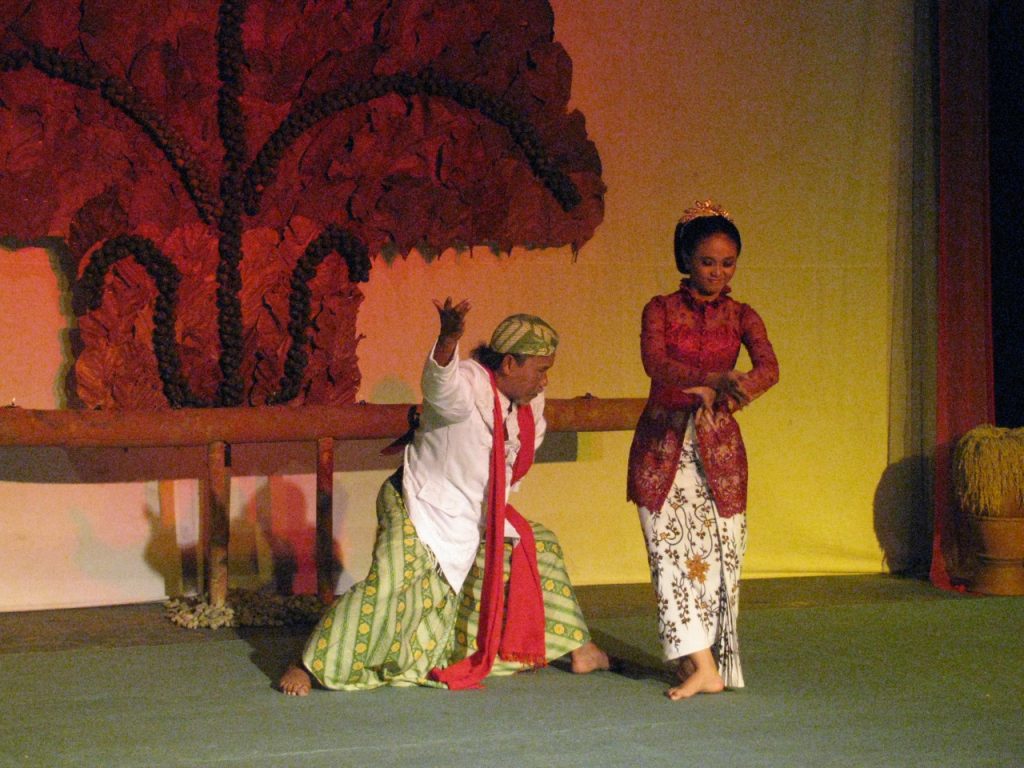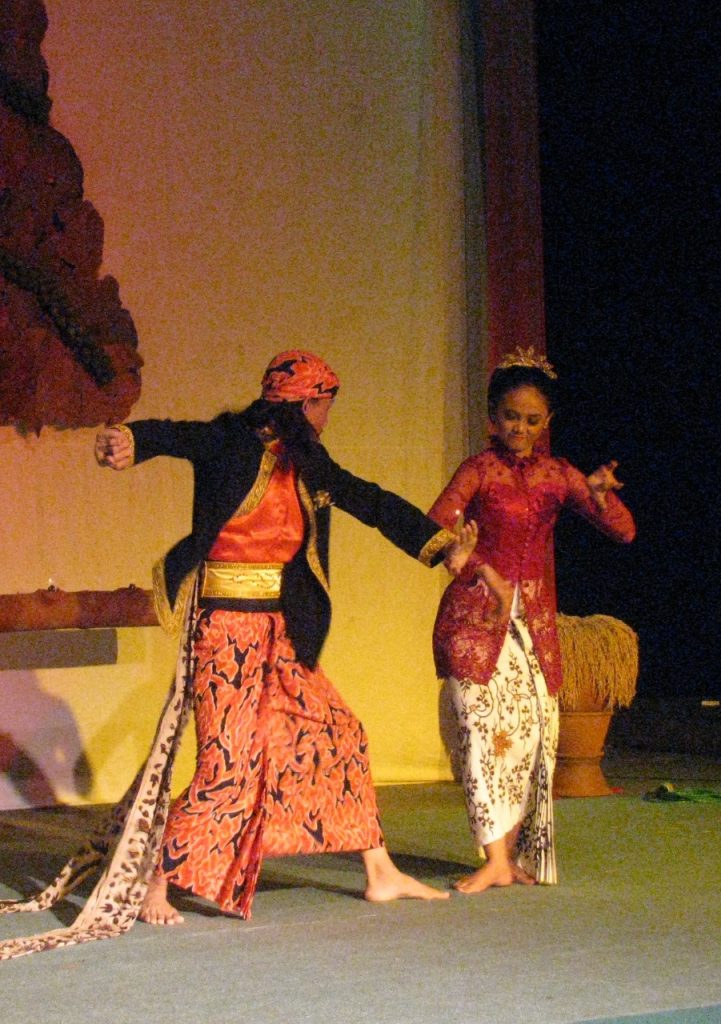
The term Tayub or tayuban is taken from several sources, including a young scholar from northern Cirebon who explained that tayuban comes from the word toyib-toyiba meaning one who does good. This word then changed his speech to Tayub/tayuban. Then wayang stories and cultural magazines such as spirit spreaders, kawit, and others, mention the term anayuba andrawina which means a party with liquor. In addition to the city of Cirebon, Tayuban art is also available in West Java and Central Java. Although the name is the same, there are differences. Tayuban Cirebon has its own norms and rules. Tayuban is a social dance. Tayub dance performances require a lot of funds, so only certain people with sufficient financial capacity can organize a Tayuban performance. In certain events, for example the Nadran ceremony, Tayuban is done with mutual cooperation funds. The dance in tayuban is not too difficult, as long as the person can understand the rules or understand the rhythm by hitting the gong, it is certain that the person can dance.
The first function is the ritual function in marriage, which is performed when the groom meets the bride. During this event, the dancer/ronggeng of tayub invites the groom to ngibing (dance) with him. The scene of the joint dance, which is sometimes accompanied by kisses, symbolizes the power relationship between men and women, who in marriage are believed to present sympathetic magical powers, some even think that ronggeng tayub has powers like a shaman to provide a means of healing. While the function of the tayuban ritual related to agriculture is held when the harvest is over which is held at the pavilion or village hall or carried out on the edge of the rice fields.
There are several supporting equipment in the show, including:
1. Executors who have the responsibility of Kanjeng Sultan, are the pangagung dalem under the leadership of the Kajeron which is called the Committee.
2. Putri Bedaya, namely a young woman who was handed over by her parents to serve in the palace. These bedaya princesses are often used as friends to dance with great guest, and then they are called Ronggeng.
3. The great guest accompanying Putri Bedaya is called Sema.
4. The bodyguard who accompanies the great guest is called Maeri
5. The senders of the drinks are called Senders Waditra which accompanies the tayub dance with a set of gamelan ageng made of bronze, usually with a pelog barrel. The waditra are Genta, klenengan (buffalo necklace made of bronze), Gendang, Bedug, Saron, Bonang, Kecrek, Keprak, Flute Bangsing, Kedemung, Kenong, Xylophone, Ketap kempyang, and Gong.
Wiyaga (the musicians) for Tayuban is almost the same as the wiyaga for wayang kulit. Gamelan and Wiyaga are managed by the village head of Sekar. A total of 15 people consisting of: one lurah sekar, a drum player, xylophone player, kecrek player, flute player, kedemung player, kenong player, gong player, laden player, two saron players, and bonang players. The clothes worn by Wiyaga are Bendo, batik cloth, piety clothes, and sontog pants. The clothes worn by the ronggeng are: Kembang goyang, sanggung bokor cinatok, sangsangan, gold suweng with intense edges, jasmine suren, kemben, sampur cinde, nyamping, kemben, and golden slepe or kestagen with intense edges. For clothing sema adjusted to the rank and position. Other complementary ingredients are yellow silk cinde with a golden ombyok, amparan demonstration cups made of carved wood, demonstration cups with a piece of endog (egg) model made of porcelain with red and blue flower ornaments, consisting of rose water or sherbet or traditional herbal medicine.
The performers/supporters of Tayuban Cirebon are as follows:
1. Madapan or Committee
In ancient times it was better known as the Pengagung Dalem under the leadership of the Royal Patih.
2. Ronggeng (concurrently sinden / singer)
In the past it was done by daughters from outside the palace who were handed over by their parents as a service.
3. Sema or guest
Distinguished guests or honored guests
4. Maeri
Escort of the great guest or honored guest
5. Sender
Special officers who bring drinks for the guests after the dance. These drinks are in the form of herbal drinks or traditional herbal medicine, now these drinks are usually called alcoholic drinks.
6. Lurah Sekar
Leader and person in charge of wiyaga and gamelan
The course of the Tayub dance performance is as follows:
a. Lurah Sekar or Penitia manages all the wiyaga and gamelan.
b. Opening song with Gimping walik or bayeman.
c. After the guests arrive, the gamelan changes songs, accompanying the solo dance or rampak performed by the ronggeng.
d. After the opening dance, it is continued with the penglabur dance, which is a dance performed by the host.
e. When the Penglapur dance is finished, the sema I (penyoder) is usually handed over to the person who came first or the guest who is honored.
f. Soder is accompanied by maeri. Maeri as a companion must have the same social status as a soder. Companion III (sema III) prepares a drink of honor to send. The song accompaniment for the dance is adjusted to the singer’s taste, usually Cirebonan songs. Sema III may be a person with a lower social status than priests and maeri.
g. After drinking, the singer invites the sender to dance, the song according to the dancer’s taste.
h. After the sender is satisfied with the dance, the singer is obliged to pay for the food, which means he is obliged to pay for one round of the show. The cooking money will be divided between the ronggeng and the wiyaga.
There is another thing called Kornelan which means giving a tip to Wiyaga by turning the bonang over. This cornelan is a sign that Wijaga does not want to continue the show, if the upside down bonang is not given a tip. Giving food money means a one-act tayuban performance accompanied by the song Oyong-oyong bangkong and marked by the sound of a bell followed by the gamelan Playon. Soder handed it back to the committee. The next round is that the perpetrator of the solder becomes the sender, the sender becomes the maeri becomes the solder. When this round is over, ?babakan Gede? tayub dance. This continues over and over again until everyone gets a turn. Tayuban dance is a social dance, even though initially it was only in the palace environment, but now the tayub art has become popular in the community.
Penulis :
Salsabilla Riska
Source:
https://warisanbudaya.kemdikbud.go.id/?newdetail&detailCatat=6876
https://disbudpar.cirebonkota.go.id/2022/04/28/tayuban-kesenian-cirebon/
http://wisatadanbudaya.blogspot.com/2009/11/kesenian-tayuban.html



